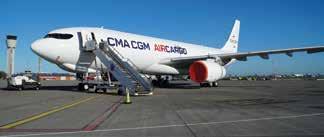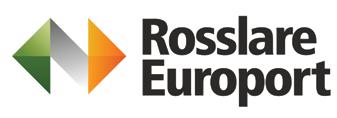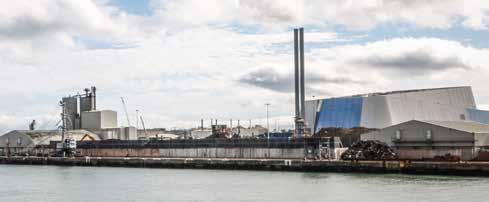
14 minute read
FLEEt MarItIME
Vol 18, No. 1 – SPRING 2022
SHIPPING & FREIGHT NEWSLETTER – Compiled by Howard Knott – howard@fleet.ie
Dover Straits operations are very much alive and kicking
As January 2021 dawned and Brexit became a reality, there was a high level of anxiety among all businesses involved in logistics operations moving across the Dover Straits as to what would happen as the new controls came into play. Partly due to the high level of product shipping and stocking in the preceding months, freight volumes through the corridor were significantly down. Much of the Irish Landbridge traffic was diverted to new and existing direct routes to and from the continent, but as the year went on, shipping volumes both by Cross-Channel ferries and on Eurotunnel services recovered somewhat.
Part of the reason behind the recovery was the deferral by the British Authorities of many of the Customs and other Brexit inspired goods control measures that should have been carried out at British ports. This was done to give British traders more time to get their back-office systems in place to develop and produce the required documents. The lack of major congestion around the Channel ports also made it easier for vehicles including those involved in Irish Landbridge freight to keep to schedule, and to match, if not beat the schedules of the new and expanded direct ferry services between Ireland and French ports. It also became clear that freight rates charged to road transport operators made using the direct ferries more expensive than the Landbridge for many locations. Despite the very significant reduction in passenger traffic on all ferry routes due to COVID-19 travel restrictions, suitable ferries for these longer routes were in short supply, pushing up the charter costs of any available vessels.
Irish Ferries took the Isle of Inishmore off the Rosslare/Pembroke route and following her customisation introduced her to launch its new Dover/Calais service in July. At the same time DFDS brought in its first e-Flexer vessel to displace Calais Seaways. That vessel was subsequently bought by Irish Ferries, entering service in January 2022 as the Isle of Innisfree.
By then Irish Ferries had bought a further vessel, the Cuidad de Mahon, which had, following her launch in 2000 as Northern Merchant, operated on the Norfolk Line Dover Straits service until 2006. The 2,000 lane metre vessel is due to enter Irish Ferries service in February 2022. With the three vessels in operation, Irish Ferries can then offer fifteen sailings each way on the Dover/Calais route, making it a very strong Landbridge package for Irish freight forwards and hauliers.
In January 2022, Guangzhou Shipyard in China launched the P&O Pioneer, the first of a pair of double-ended ferries built for P&O Ferries which will enter service on the Dover/Calais route in September 2022. Sister ship, P&O Liberte is planned to enter service in March 2023. Each of these vessels has significantly better environmental credentials than any of the current Dover Straits vessels.
Though DFDS did introduce a daily Sheerness/Calais service in August 2021 as a congestion busting operation, it remains the only new service that sets out to displace traffic from Dover Straits services. Some schedule changes have been made on North Sea services linking Britain with Benelux countries but there has been nothing dramatic. 1 January, 2022 should have been the date on which the full range of Border controls on traffic moving between EU and Britain took effect and there were concerns in the lead up to this that these would prompt significant delays at Channel Ports. In the event some of these changes were implemented while others were pushed out further into 2022 and no changes were made regarding island of Ireland/Britain arrangements pending resolution of the Northern Ireland Protocol difficulties.
Dublin Port

The pace of change towards low-carbon shipping picks up
There are many similarities between the ways in which ship owners and hauliers are moving towards a low-carbon future. The shipping industry carries over 80% of all goods traded globally, but also accounts for almost 3% of man-made carbon dioxide emissions with pollution levels being most severe in coastal regions. However, it did start from further back, with almost all vessels launched up to the middle of the last decade having had engines running on heavy fuel oil, albeit with several of them using lower sulphur product for operating the auxiliary generating equipment while in port.
The introduction of “low-emission zones” by the international Maritime Organization, initially in Northern Europe, the North Sea and in some North American coastal regions, forced shipowners and operators to either fit Exhaust Gas Scrubbers to eliminate most of carbon discharge, or to use low-sulphur fuel. Other oceans and seas are being added to the “low emission zone” map, including the Mediterranean Sea from 2026. At the launch of these new rules there was scepticism about the value of retrofitting exhaust scrubbers, but as fuel prices have risen their value becomes more apparent.
Over the past ten years extensive trials have been carried out seeking to make use of wind power with a few Scandinavian based ferries and some smaller cargo vessels being fitted with rotors with fuel savings of up to 20% being recorded.
A similar level of fuel savings is being claimed by specialist kite manufacturer, Seawing, through the deployment of kites of up to 1,000 square metres flying at an altitude of 300 metres on vessels sailing in the Trade Wind regions. An early adopter of this technology is Airbus Industries which is using a kite to power its vessel Ville de Bordeaux which sails with a cargo of aircraft components from European production facilities to its US assembly plant.
Radical changes in ship design, particularly with the underwater profile and in the coating used to make the hulls more “slippy” have also begun to play a role in fuel use reduction.
The most significant developments however, mirror what has been happening in the HGV and bus sectors. Short Sea Line Samskip has introduced a biofuel component in the fuel oil being used on one of its container vessels serving the Irish market, while competitor Containerships has built and introduced LNG natural gas powered vessels onto its European route network. Containerships’ parent company, the CMA-CGM group, has built and deployed a fleet of LNG powered vessels onto its Asia/Europe routes.
CLdN, which operates a mix of ConRo vessels on its services throughout Europe, has introduced its first vessel equipped with an LNG, high-pressure, two-stroke, dual fuel propulsion system that can operate on liquified natural gas, biogas, or diesel. The vessel Faustine is a sister ship of Delphine which is a regular caller to Dublin on the company’s Zeebrugge and Rotterdam services. A further similar vessel will join the fleet in the coming months. Brittany Ferries will introduce the e-Flexer Salamanca to its Portsmouth to Spain routes in February with a fuel use capability like that of the CLdN vessel and with a planned reduction in CO2 emission of 25% compared with her conventionally fuelled sister ship operating on a similar route network.
As with the road transport industry, many ship operators are uncertain as to the long-term future of LNG as a fuel that can achieve the low-carbon ambitions at a stable cost. There is the further concern that, unlike road transport vehicles, ships generally have significantly longer operational life – most ferries remain in front-line operation for up to thirty years while container ships generally move onto secondary trades within fifteen to twenty years. Thus, a ferry that enters service in 2022 could be still sailing in 2052, a couple of years after the zero emissions target for the industry has been reached.
UECC, the specialist trade car carrier which operates a European network of services for the motor industry, has launched its third advanced dual-fuel LNG battery hybrid PCTCs (pure car, truck carriers) at China’s Jiangnan Shipyard. “We are rapidly building up our low-emission fleet to become the leading eco-friendly short-sea carrier in Europe through the addition of these new-builds that will, alongside the use of alternative fuels on our existing vessels,
drastically reduce UECC’s environmental footprint,” stated CEO Glenn Edvardsen.
The innovative use of battery hybrid technology, combined with a dual-fuel solution, on the latest new-builds will enable these vessels to exceed the IMO’s goal to cut carbon intensity by 40% by 2030 compared with 2008 levels. Emissions of carbon dioxide will be reduced by around 25%, while sulphur oxide (SOx ) particulate matter will drop by 90% and that of nitrogen oxides (NOx) by 85% through the use of LNG. The new-builds will also meet the IMO’s Tier
CLdN Delphine
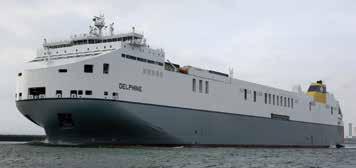

3 NOx emissions limitations for the North Sea and Baltic Sea.
With the addition of the new-builds, UECC will have 80% of its total lifting capacity meeting or exceeding the IMO target already this year as it aims to achieve an annual cut of 34,500 tonnes in CO2 emissions by 2025, compared with 18,700 tonnes in 2020 and 277 tonnes in 2016.
The development of use of battery power in the shipping industry has, up to now, been slow, with its use being confined to operating in conjunction with conventional power and for activities within ports or other sensitive areas. Range anxiety remains an issue, even with the heavily promoted Stena Line Elektra project which should see a pair of battery powered ferries introduced on its Gothenburg/ Frederikshavn route in 2030.
According to Patrik Almqvist, Head of Network and Fleet at Stena Line, there are several reasons why the shipping industry has lagged other transport
areas in the field of electro-mobility. “For large ferries, batteries are a considerable challenge. It takes a huge amount of energy to move a ship across the water, which of course affects the bulk of batteries needed. Another large obstacle is how to charge these batteries when in port. In simpler terms: the challenge grows with the size of the transport,” he said. The vessels currently being designed would be of comparable size and capacity to the company’s vessels currently on Irish Sea routes and Almqvist goes on to say that the technology available by 2030 may not be capable of delivering full electric propulsion within that timeframe.
Maersk Line has held back from ordering new tonnage for the last couple of years stating that it has been uncertain as to what is the best fuel/propulsion system to choose. It has not followed competitors into LNG, but in December 2021 it ordered eight 16,000 TEU capacity vessels powered by ”carbon-neutral methanol” with an alternative capability for low sulphur diesel fuel.
“Today, we introduce the design of our eight ground-breaking and industry-leading 16,000 TEU container vessels powered by carbon-neutral methanol,” announced Palle Laursen, chief technical officer, A.P. Moller – Maersk. He said the new ships, to be built by Hyundai Heavy Industries in South Korea, “come with an innovative dual-fuel engine setup that can operate on methanol and conventional low-sulphur fuel.” He added: “The vessels will be able to complete an entire round-trip, for example Asia-Europe, on green methanol.” Laursen explained: “Unique to the industry, this design allows a 20% improved energy efficiency per transported container, when comparing to the industry average for vessels in this size. Additionally, the entire series is expected to save around one million tons of annual CO2 emissions, offering our customers carbon-neutral transportation at scale on ocean trades.”
In 2015, Stena Line converted the ferry Stena Germanica to operate in an analogous manner by making use of waste methanol. To date, the company has not pursued such systems any further.
The development of hydrogen as a fuel for commercial shipping continues apace, particularly in Scandinavia. Gotland Horizon will be Sweden’s first large-scale hydrogen-powered vessel for both passengers and freight, with water as the only emission.
Gotland Horizon is the project name for the ships of the future sailing between the Swedish mainland and the Baltic Sea island. Developed by Rederi AB Gotland, Destination Gotland and Gotland Tech Development, the ships are designed to be powered by fossil-free hydrogen. With gas turbines in combination with steam turbines, the goal is that traffic to and from Gotland will continue at the same speed and service as today, but without negative emissions. In addition, the gas turbines, through their multi-fuel function, are prepared to handle other types of fossil-free fuels in step with technological development and the availability of various fuels. The project hopes that an emission-free Gotland trip will be possible as early as 2030.
Similar to the land-based discussions on alternative fuels, the significant issue for shipping lines moving away from the established fuel mixes revolves around the availability of those fuels and the prices at which they can be delivered. As the “new” fuels being brought into play for all transport modes are similar, there will be considerable competition between sectors for these fuels, even more so as world trade volumes continue to increase.
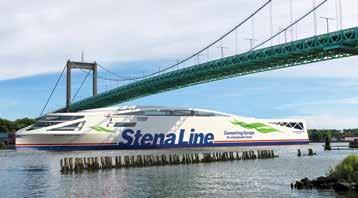
Stena Line Elektra Methanol fuelled Stena Pro Patria
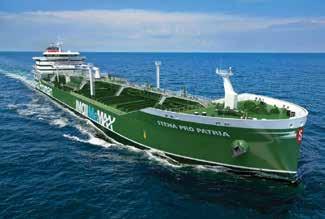
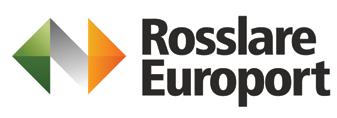
port of Cork’s almost complete Ringaskiddy Port facility welcomed the biggest ever car carrier to the port in December 2021. The EUKOR operated vessel Morning Laura discharged 682 vehicles at the terminal of which almost 40% were Electric Vehicles from manufacturers including Hyundai, Kia, and SsangYong. Established car shipping business at the port includes the twice weekly calls there by Grimaldi Line. The Port expects to open the container handling facilities at the new facility later in the spring.
Danish managed but DP World owned Unifeeder has opened a new Irish service, providing weekly links from the ports of Belfast, Dublin, and Cork with Rotterdam. This Lo-Lo container service operates in addition to the Belfast, Dublin, Cork, and Southampton service introduced in July 2021. Unifeeder is a long-established deep-sea feeder service operator, though it also has several door-to-door operations throughout Europe.
In December, Cherbourg port handled its 100,000th trailer on the Irish services operating through the port. In 2021 the freight traffic volumes increased to three times the previous
year volumes and confirmed the port as market leader. Between them Stena Line, Irish Ferries, and Brittany Ferries presently operate up to three departures a day, six days a week from Cherbourg, with an average ferry crossing time to Ireland of about 17 hours. The number of unaccompanied trailers through the port has increased from about 20,000 in 2020 to 45,000 in 2021. During 2022 the multimodal transport terminal for the planned Bayonne/Cherbourg rail motorway service, which has been financially backed by Brittany Ferries and the French Ministry of Transport, will be completed.
In December Stena Line introduced the chartered Seatruck Panorama to run alongside the Stena Horizon on its Cherbourg/Rosslare route, while in November Brittany Ferries opened a weekly Rosslare/Le Havre link using the 2,200 lane-metre ferry Cotentin. Samskip has announced that it is bringing together expertise from its Bremen-based project cargo business and its dedicated air freight team at Schiphol airport in the Netherlands to leverage its full potential as the “hidden gem” in special load logistics. The joint initiative creates a focus for capabilities which extend from express air freight delivery, through breakbulk, heavy lift and out-of-gauge special cargoes movements by sea. The one-stopshop service includes coordinated plane and ship chartering by Samskip. “We are extending our ability to overcome exceptional transport challenges by bringing together proven expertise in air and ocean logistics,” said Jens Siedentopf, Head of Breakbulk Projects, Samskip. Mostly associated with multimodal transport, Samskip has identified project cargoes as a strong opportunity for growth, based on its global logistics presence and the potential to coordinate with its shortsea, rail, trucking and inland barge service network. The opportunity to add airfreight to the project cargo mix follows the launch of Samskip Air in May 2021.
Samskip is not the only shipping line to move decisively into the air freight space, following CMa-CGM which continues to build up its own fleet of cargo aircraft and has commenced the operation of regular transatlantic services. MSC and Maersk are also building similar operations as part of their missions to offer customers a ‘one-stop shop’ to meet their logistics requirements.
The European Sea ports organisation (ESPO) has welcomed the European Commission proposal setting out the new guidelines for the Trans-European Transport Network (TEN-T). ESPO has stated that the proposal, published on 14 December, lifts the importance of the maritime dimension and the role of ports within the framework of Europe’s TEN-T policy. It defines maritime ports as the entry and exit points for the land infrastructure of the trans-European transport network, and for the first time explicitly recognises their role as cross-border multimodal nodes which serve not only as transport hubs, but also as gateways for trade, industrial clusters, and energy hubs. The revised TEN-T map excludes the UK and links the Ports of Dublin, Cork and Shannon/Foynes with a number of French “Tier 1”. Ports.Cherbourg
Seatruck Panorama
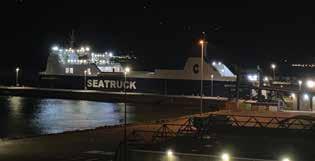
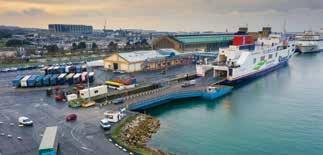
CMA CGM Air Cargo ECS
